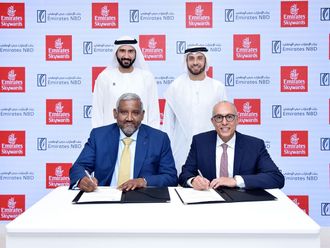
Recently MasterCard brought its Priceless Cities campaign to the region with Priceless Arabia. Not to be outdone, Visa launched its 2013 Premium Access programme — where cardholders can enjoy unique experiences and privileges from Visa when they book their next holiday. Joining the pack is Qatar National Bank, which launched the World Elite MasterCard in the Middle East and Africa that targets the VIP luxury traveller. Then there is the Standard Chartered Visa Infinite credit card that is being marketed as a premium lifestyle card. And most recently, United Arab Bank launched its premier card, the United Arab Bank Visa Infinite credit card, offering a wide array of privileges and convenience for elite customers in the UAE.
These cards are in a league of their own — they typically offer first-class airport lounge access; personal concierge services; complimentary luxury gifts; a wide array of travel-related insurances free of charge; and travel benefits and discounts including upgrades, often by invitation only. While these may be staples that have been around for a while, the new generation of cards is offering all this and more in terms of memorable experiences.
Something extra
The MasterCard Priceless Cities programme is a long-term platform dedicated to bringing customers closer to their passions. The idea is to transform the MasterCard brand from one that celebrates priceless moments to one that now brings these priceless experiences to life, thus engaging with consumers in new and exciting ways.
“Priceless Arabia is the first region-wide Priceless Cities initiative that recognises and celebrates the entire region. The GCC not only offers a variety of unique experiences but is also home to some of the world’s most affluent target audiences,” says Eslam Darwish, Head of Marketing, Middle East and Africa, MasterCard.
Affluent consumer values are evolving from the material to the experiential, he explains, driving new and different credit-card needs. “Today, affluent consumers want their credit card to provide recognition and exclusivity, preferential access and treatment, as well as global acceptance and exceptional service,” adds Darwish.
It’s obvious that the company has its finger on the pulse, as MasterCard’s reported net revenue for the third quarter of 2013 was $2.2 billion (Dh8.1 billion), a 16 per cent increase over the same period in 2012.
It’s the same theory being applied across the board. UAB Visa Infinite card-holders will enjoy higher points with UAB Rewards, the bank’s loyalty program. In addition, the card offers a host of travel and lifestyle privileges including the prestigious Black-tier Harrods rewards card, gold membership to the Hilton Honors program, and discounts at golf courses worldwide. “The card is targeted at the affluent segment of customers who constantly seek premium privileges and rewards. This card will provide cardholders with great experiences and a variety of niche offers to match their lifestyle. The possibilities are infinite,” says Tony B Graham, Executive Vice President, Retail Banking, United Arab Bank.
Growing affluence
The irony is that we are told we live in financially uncertain times, with the US having just about escaped the recession hole it had dug for itself, Europe still on crutches and the Asian giants slowing down. So who are these premium credit cards targeting and what’s new on offer?
The truth is that there is no dearth of affluent customers that are a perfect fit for premium cards. According to the UBS/Wealth-X 2013 World Ultra Wealth Report released in September, the rich are getting richer. While their cumulative wealth increased by $1.7 trillion, the report also confirms the population of ultra-high net-worth individuals (classed as head of households with a net worth of $30 million and above) at nearly 200,000.
In other words, there is a very lucrative and expanding market for premium credit cards that financial institutions and banks are keen on slicing up for themselves. But apart from that, there are other key factors that are making these products so pertinent for the region.
“In the region, we are seeing a surge in the number of premium credit-card holders with the upper affluent segment one of the fastest-growing sections of society,” says Marcello Baricordi, General Manager UAE and Global Accounts Lead at Visa, Mena. “According to the Visa Affluent Study 2013, almost the entire affluent segment in the UAE make regular trips abroad. In fact, over the past 12 months, 94 per cent of them went abroad and 96 per cent plan to do so over the next 12 months,” he says.
“The study also found that for the affluent segment, having access to the best the world has to offer, and enjoying services and experiences catered to their preferences are some of their top demands,” adds Baricordi.
Over the past few years, the affluent segment has emerged with one of the fastest-growing product portfolios and this has greatly benefited credit-card companies as markets such as the UAE are increasingly going cashless. According to MasterCard’s new global report The Cashless Journey, the UAE ranks among the economies that are most rapidly moving away from being a predominantly cash-based society. With a Trajectory Indicator of 65, the UAE has one of the faster-changing payments ecosystems of all 33 countries studied.
The travel hook
What better promise of excitement and wonder can there be than a piece of plastic transforming itself into a magic carpet that helps you explore the world?
There is a strong connection between luxury travel and premium credit cards, explains Ross Maclean, Customer Advisory Leader, Ernst and Young Mena. “If you look proportionately at the amount of money spent on hotels, flights and accommodation, it makes good sense for credit-card companies to target these higher value transactions. Business travellers often rack up thousands of dollars a month in expenses on these items so it is little wonder they are targeting these segments.”
The impact of travel and tourism on economic growth is significant. The industry is forecast to grow at an average of 4 per cent annually over the next ten years. In 2012 alone, it contributed to 9 per cent of global GDP. Last year also witnessed a landmark for international tourism as the yearly number of international trips taken surpassed the one billion mark for the first time. This all presents exciting opportunities for players in one of the world’s largest industries.
Today’s typical traveller spent an average of $2,390 on their last trip. This spend is expected to grow by 5 per cent to $2,501 for their next trip, states the latest Global Travel Intentions Study 2013. While Australian travellers are among the top spenders on the global stage, the travel budgets of those from emerging markets are also high with two of the top three spenders hailing from these emerging economies — Saudi Arabia ($6,666) and China ($3,824).
According to Dubai’s Department of Tourism and Commerce Marketing (DTCM), the emirate received 5.58 million tourists over the first six months of 2013, which represents an 11 per cent year-on-year increase.
“The affluent consumer is an avid traveller and availing of travel-related benefits with distinguished rewards is a key priority for them,” says Darwish. “Locally, the most recent MasterCard Travel survey shows that 70 per cent of UAE consumers are set to travel for leisure in the coming months, with the majority aiming to travel to Asia-Pacific markets. This is a good indicator of the affluent segment’s travel appetite. It is only natural now for the consumer to expect the same value-added benefits from the regional products that they experience while on overseas travel.”
As the use of digital currency continues to play a significant and growing role, banks and financial service providers will work closely with the retail and tourism industry to ensure that consumers reap the maximum benefit.












